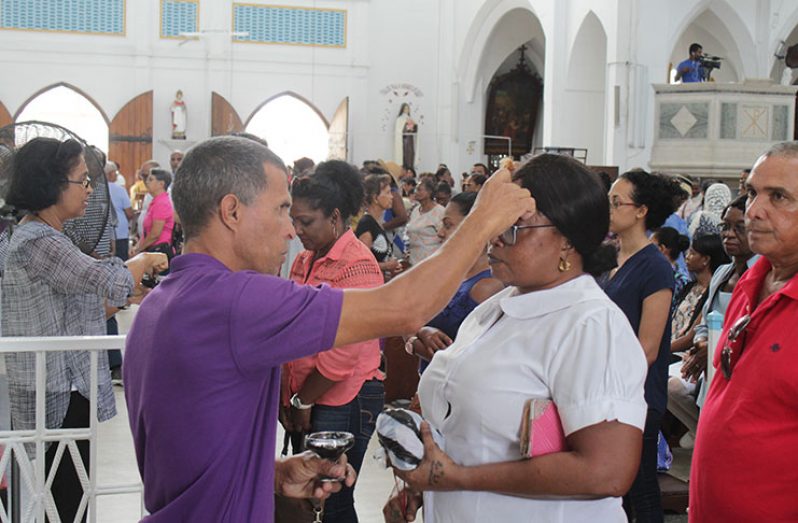JUST before Wednesday midday, hundreds of persons entered into the largely unpainted edifice on Brickdam known as the Cathedral of the Immaculate Conception, or simply, the Brickdam Cathedral.
A regular onlooker would wonder why so many persons, including men and women, dressed for work and children in their school clothes would be entering the church at that time of the day. But as persons began leaving with a black ‘cross’ inscribed on their foreheads, the answer would become apparent; it was ‘Ash Wednesday’.
Father Carl Philadelphia, the priest at the Cathedral, was donned in his ceremonial robe and was standing below the alter applying the crosses to the hundreds of persons queued in the cathedral.
His ministers, positioned across the floor, assisted him.

“The significance of Ash Wednesday, within the Catholic Church, is that this signals the beginning of Lent for us,” Father Carl told Guyana Chronicle.
On this day, during the traditional Catholic Mass, the priest (sometimes aided by other church ministers) applies moistened ashes of palm branches on the forehead of persons. It is applied in the shape of the cross and as it is applied, the receiver is told: “Remember that you are dust, and to dust you shall return.”
According to Father Carl, the application of the ashes is a symbolic ritual. In fact, he shared that in the Old Testament, followers engaged in penance by rubbing dust and ashes on their skin.
Catholics and non-Catholics receive the ashes, recognising that within themselves, they are preparing to go into that Lenten observance and engage in penance.
As documented in the Bible (the Christian book of sacred scriptures), Jesus Christ (the Son of God) was tried and tempted in the desert for 40 days and 40 nights while he was engaged in prayer and fasting.
SYMBOLIC
Lent is similarly observed for 40 days and is supposed to mirror Jesus’ experiences in the desert. Father Carl, however, explained that symbolism of the desert, i.e. the trials and temptations, is reflected upon but that does not connote that the desert is “something negative”.
“The desert represented the transition from struggling to life and life with Christ,” he clarified.
“The season of Lent is a period of self-denial,” the priest explained also. Just as Jesus resisted the temptations, trials and tribulations he faced during that time, so too are Christians encouraged to do the same.
In fact, throughout this period of Lent, Catholics and other members of the Christian community engage in four major tenets: increasing prayer, penance, almsgiving and fasting.
Usually, the worshippers would engage in fasts, or at least forgo certain foods such as meats, sweets or fast food. They would also forgo activities deemed as sinful, such as consuming alcohol. The worshippers are also expected to provide assistance to those in need.
“All of these things are done with a purpose and the purpose is so that we can become closer to God and become like Jesus, i.e., become people who are more considerate, loving, kind and compassionate to our brothers and sisters,” the priest explained.
Furthermore, he explained that these tenets are considered to be sacred duties of Christians and when engaged in, would enable them to become better followers.
INTROSPECTION
Introspection is also important during this season, according to the respected religious leader. Through introspection, he said worshippers are encouraged to reflect on their lives to discover the ways in which they have not been living as per God’s commandments.
“When we do that reflection, we can come and be repentful and do penance to be better Christians,” he said and posited, “It is good to repair.”

One young Catholic, Joshua Vansluytman shared: “For me, Ash Wednesday means for me to evaluate myself and start all over again and to celebrate the risen Christ.”
Lent also signifies ‘spring’ and Christians, particularly Catholics, view the springtime as a period where they are renewed and refreshed through the Lenten observances.
Eventually, within the Cathedral, the lines get shorter and shorter until the hundreds of persons have all had the ‘cross’ plastered on their foreheads. It is here that the Catholic Mass takes shape.
Catholicism is the main and earliest form of Christianity and its mass is deemed as the central form of worship here. At the Brickdam Cathedral, the seats were filled as Father Carl led the gathering in prayer. His words echoed throughout the halls of the Cathedral and soon enough, a resounding “Amen” was heard as the worshippers ended their prayers after him.
But soon after the worship ends, the other segment of the sacred mass begins — the Eucharist (also known as the Holy Communion). The queues are formed once more but, instead of applying the ashes to the forehead, the worshippers are given bread.
The communion mirrors Jesus’ final supper, before his crucifixion, with his 12 disciples, and as explained by Father Carl, Jesus gave them bread with the words “This is my body,” and then wine with the words: “This is my blood.”
“For us, it is receiving Jesus. It is in remembrance of him and what he did for us,” Father Carl said. In Christianity, it is accepted that Jesus died to pay for the sins of the world.
In remembering that Jesus died for others, Father Carl stressed the importance of prayers for Guyana at this time.
“Right now, within our country, we are going through some division, especially in our political arena, but we should remember that we serve a God and a God of unity, not division. We need to pray that we become closer to God, no matter our faith or so on, [and] to become good people who are good to each other. This is embodied in our [National] motto: One People, One Nation, One Destiny,” he said.



.jpg)








